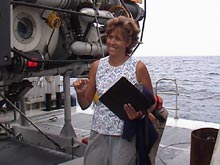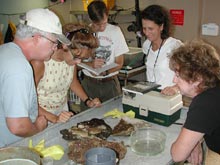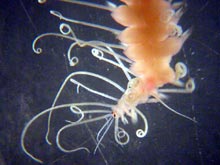
Immediately after returning from a depth of 200 ft, Educator-at-sea Connie Leverett describes what it was like to dive in the Johnson-Sea-Link II submersible. Click image for larger view.
Kids at Sea!
August 10, 2003
Connie Leverett
Educator-at-sea
Burke High School, Charleston, SC
The air of discovery that permeates the lab is a connection that these scientists have to every child. Every day is a day of discovery! When buckets from the submersible are unloaded into the wet lab, the scientists huddle around, hoping to find new creatures and rocks that may define the fascinating habitat of the Charleston Bump.
The reason I became a teacher was to share my love of the natural world and its origins with students. Labs are my favorite activities because as students make discoveries, they immediately want to share them. “Mrs. Leverett, come look at this cool worm! It’s eating all the pond scum!” or “Mrs. Leverett, come see these cells during cytokinesis!”

Jostling to see the latest samples from 1,400 ft, a few of the expedition's "kids at sea" gather around the table in the wet lab. Click image for larger view.
On this cruise, the scientists want to share their discoveries just like my students. As Susan Thornton-DeVictor and I were preserving various collections from the sub trips, Jerry McLelland kept coming over and finding some wonderful worm or brittle star to view under his microscope. Then he hit paydirt. He found a polychaete worm that looked like interactive art!
This beautiful orange segmented worm, a Syllid (related to earthworms), has long white appendages called "dorsal cirri" on every segment. They curled in and out from its body like the paper party favors that children get at birthday celebrations. After he delicately placed it under the microscope, Jerry yelled, “Connie, come over and look at this!” with the same enthusiasm that my students have when they find something they have never seen before. He had never seen one this big before, and everyone on the watch came over to "ooh" and "ahh" over it.

A close-up view of the Syllid worm. Scientists aboard each sub dive also try to bring back at least one small rock. The rocks teach us more than just the geology of the ocean floor. We also use them to learn about the creatures adapted to life in these harsh habitats. Click image for larger view.
Mr. McLelland is an authority on polychaete worms, but this exploration is not just about quantifying every worm, such as the one we all admired under the scope. It is about discovering new organisms and rocks and sharing these discoveries with everyone in the lab. When Leslie Sautter, director of Project Oceanica, shares the significance of the different types of sediments found on the dives, her extensive geological knowledge is clear. Even more impressive, though, is the passion she has for her work. It's the same as the exuberance she felt as a young girl looking for rocks and finding that perfect stone with a shape and color that fascinated her. It's the same kind of enthusiasm that all children have when they make a new discovery. That kind of adventurous spirit is a part of all of us. It’s one of the characteristics in my students (and in me) that I want to foster.
This expedition is a nice reminder that we don’t have to lose our passion and excitement as we grow up. I’m happy to share in the discoveries being made here on the Charleston Bump with all these great kids . . . I mean scientists!
























